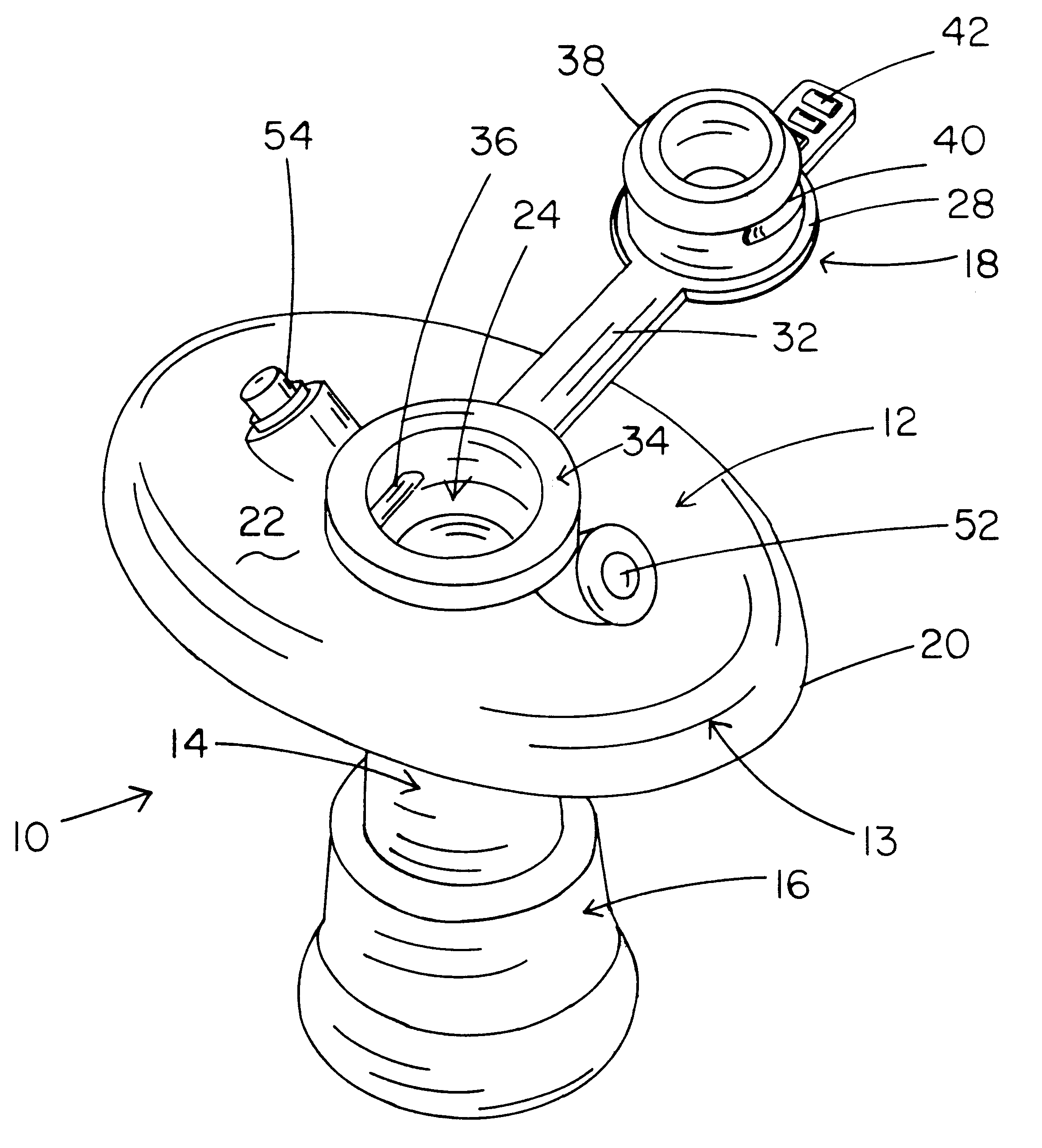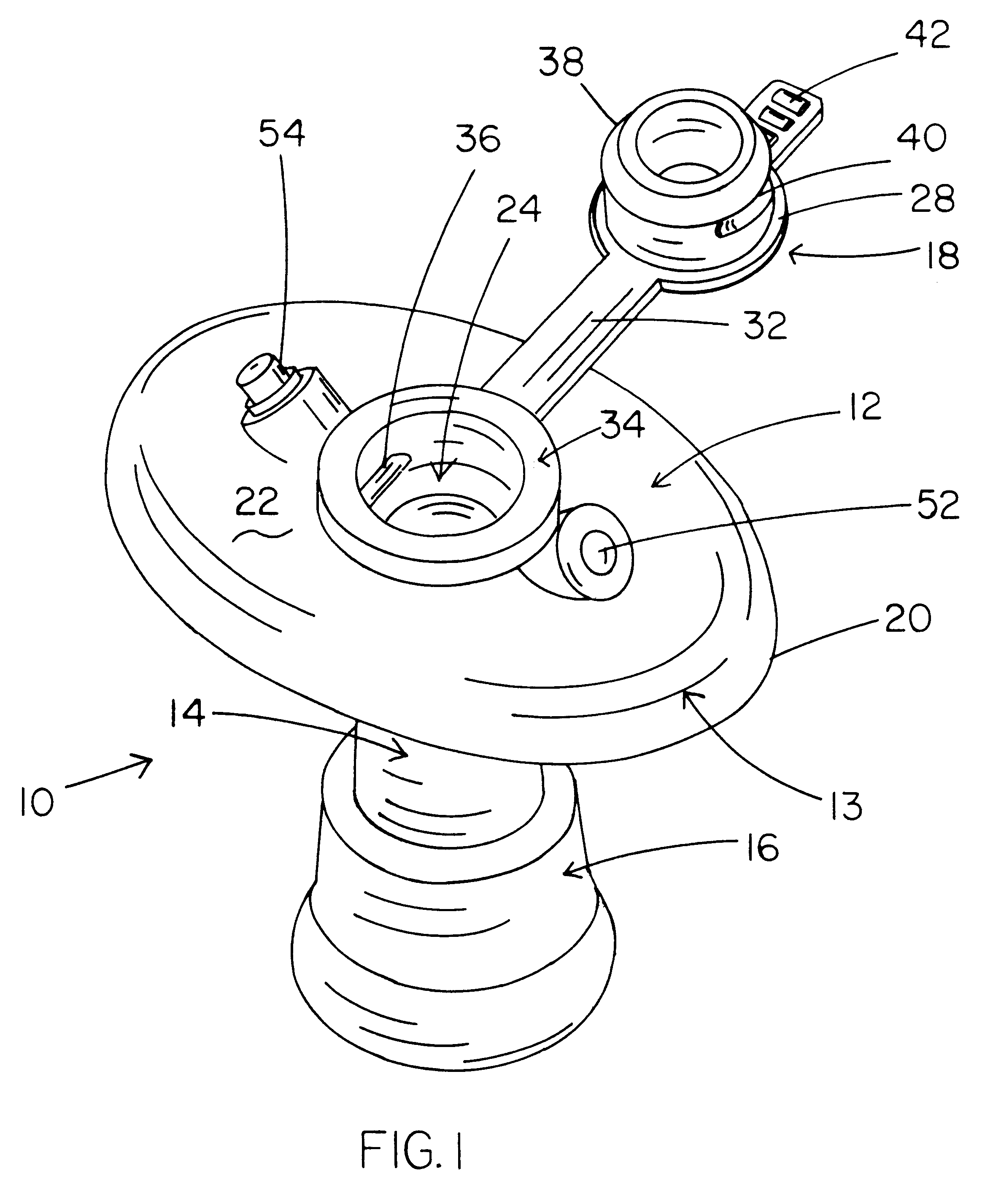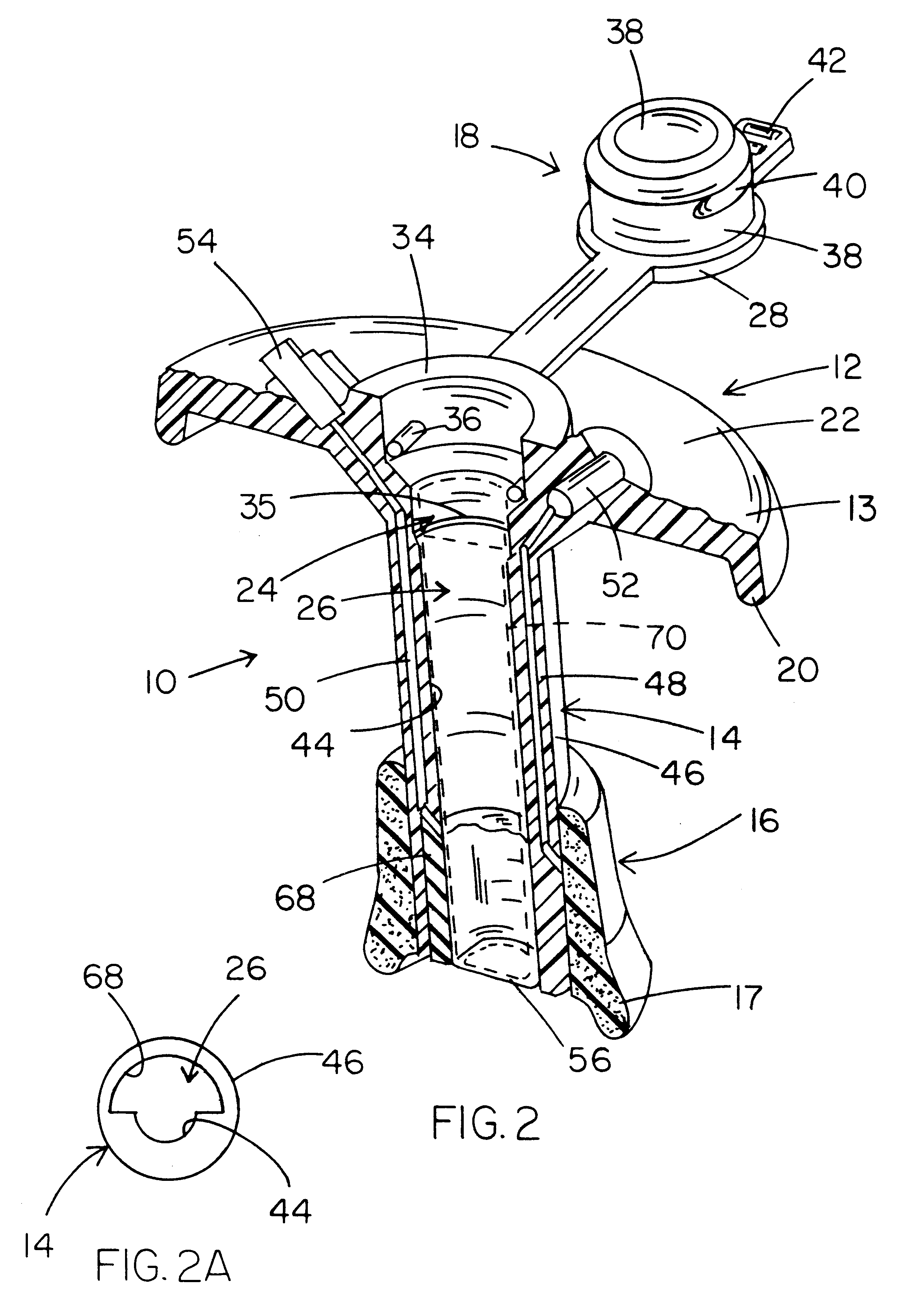Because an external pouch is not required to be worn, and there are no belts, adhesives or other additional devices required to hold the new COP securely in place, the user has the freedom to wear tighter or more-revealing clothing than would otherwise be possible, and there is no concern of noises, such as "crinkling" sounds, inherent with the usual plastic ostomy bags. The user thus is provided with a generally improved
quality of life, including enhanced body image, increased confidence and potential sexuality, and has available a wider potential
range of movement, enhancing possible athletic activities as well, without the
psychological stress of concerns with leakage and
odor. The
new device is, however, adapted for selective use with new, specially designed, drain tubes,
irrigation sets and optionally biodegradable, disposable waste bags, as well as with known styles of
drainage tubes. In addition, the device works with known internal surgically created reservoirs, such as those generally known as Kock and Indiana-type pouches. It is also suitable for use with surgically formed urinary and bowel ostomies, as well as with colostomies, and gastrostomies, and for decompression and
irrigation purposes.
It is further among the advantages of the new invention, having the features indicated, that because. of the presence of the catheter portion of the
new device in the stoma, there is reduced likelihood of stoma prolapse to the outside of the
abdomen, as well as reduced incidence of stoma retraction into the
abdomen, and reduced likelihood of strictures in the stoma. There is the further
advantage that there is no peristomal
skin trauma from heavy
colostomy bags and irritating adhesives, and the expense and bother inherent with use of pastes, glues, tapes and belts ordinarily required to keep a conventional stoma and pouch in proper placement is virtually eliminated. The
skin to port seal developed in use of the continent ostomy port described herein is not impacted by cutaneous mucous
discharge or topographical changes of the user's body due to
weight gain,
weight loss or aging, for example. An improved seal and compatibility with irregularly shaped or contoured stomas is readily accomplished with the new COP as compared with the art. Such improved sealing is seen even with use of the
new device in ostomate patients who are elderly or obese, with soft or flaccid abdomens. Embodiments of the new ostomy port include customized bolsters, bolsters of irregular / asymmetric shapes and bolsters which can adapt their shapes to accommodate. changes in the body of the user. Further, the new ostomy port can be provided with a
bolster portion disclosed. here in a variety of forms, which
bolster permits facile removal and replacement with new ostomy ports of increasingly larger sizes.
The indwelling nature of the new COP also has advantages for use in neonates or
small children, because the neonate's skin is especially sensitive to the adhesives conventionally used for attaching a bag or sealing a stoma. The neonate is also well served by the lack of necessity for the constant presence of a
colostomy pouch, because of the sheer bulk of the pouch that may overwhelm the tiny infant, literally inhibiting movement. The indwelling nature of the new COP is also ideal for ostomates who are undergoing skin-
grafting, providing reduction in the otherwise high incidences of peristomal hemation and / or
necrotizing enterocolitis ("NEC") seen in such individuals when fitted with conventional stoma pouch devices, because of the difficulties caused by the stoma environment, a
surgical wound formed in the patient's abdominal
muscle and the stapled skin over such an opening.
Thus, in furtherance of the above-mentioned goals and advantages, the present invention is, briefly; a continent ostomy port device having a face plate defining a selectively sealable aperture which is formed through and is alignable with the opening of a stoma formed in the body of a user of the device when the face plate of the device is disposed substantially parallel to the body wall of the user, over the site of the stoma, to thereby provide access to the inside of the stoma. A closure portion is connectable or connected to the face plate adjacent to the aperture and is adapted to permit selective and repeatable covering and uncovering of the aperture in the face plate. A catheter portion of the device has a first end and a second end, the first end being connected to and extending from one side of the face plate. The catheter portion extends proximally and the second end of the catheter portion is disposed interior of the user's body, within the ostomy site when the port device is in normal use position. The catheter portion has. a continuous and exterior side wall, and a continuous interior side wall defining a major lumen, which extends continuously from the aperture in the face plate to the second end of the catheter portion. The catheter portion is sized and shaped appropriately for non-surgical installation through a stoma to a sufficient distance that the presence of the catheter portion within the stoma provides a
physical barrier which reduces the incidence of stoma prolapse, without the use of extraneous, externally applied materials or additional surgery. A retaining structure is connected to the catheter of the port device or other medical catheter, and is non-surgically, snugly fittable into the stoma, and thereby causes the port device or other medical catheter to which it is connected to be self-retaining in a normal use position within a stoma of the user, without the need for special surgery and extraneous,
external fixation materials such as tape, belts, and adhesives.
The invention further includes, briefly, a removable
cartridge that is sized and shaped to fit snugly and slideably within the major lumen of the catheter portion of the. device to thereby prevent inadvertent escape of body
waste material form the stoma through the device when the
cartridge is in place, so that the user is not required to wear an ostomy bag, and to further thereby clean the. interior side wall of the catheter portion as the
cartridge is pressed into the major lumen of the catheter.
The invention also includes, briefly, as selectively operable anti-
reflux valve that is attached to the second end of the catheter portion to thereby permit blockage of the major lumen of the catheter portion by activation of the anti-
reflux valve when it is desired to prevent escape of body waste through the port device, and to permit passage of fluid or
solid material through the port device when the anti-
reflux valve is deactivated.
 Login to View More
Login to View More  Login to View More
Login to View More 


